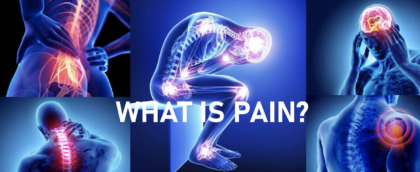What is Pain?
Pain is often classified into two subtypes, chronic and acute pain
Acute pain is often defined as having a sudden onset, lasting hours to days, with an identifiable underlying cause. Once the cause of pain is treated, the pain resolves. Acute pain is often the bodies way of communicating an issue that deserves medical attention. Ignoring such pain can lead to complications of illness including death.
Acute pain examples include but are not limited to:
- Acute appendicitis
- Bone fracture
- Burn from a hot stove
- Labor pains
The treatment for acute pain is focused on treatment of the underlying cause
Chronic pain on the other hand starts as an acute pain but remains longer than resolution of the underlying cause or time frame expected for healing.
The treatment for chronic pain is aimed at reducing the pain to give relief, limit disability and improve function. Realistic goal setting is an important component of treatment of chronic pain
Chronic pain treatment requires a multidisciplinary approach combining physical, emotional, intellectual and social skills.
Chronic pain is further divided into two categories, Nociceptive pain and neuropathic pain
Nociceptive Pain:
Nociceptive pain is pain arising from damage to tissues other than nerve fibers. It is also called tissue pain. The undamaged nerve cells called nociceptors carry the sensation to spinal cord from where it is relayed to the brain. It is called somatic pain if it results from injury to muscles, tendons and ligaments. Somatic pain is usually well localized.
Pain that is caused by injury to internal organs such as gallbladder, stomach and urinary bladder if referred to as visceral pain.
Neuropathic Pain:
Neuropathic pain is the pain caused by the lesion in the nervous system when they are structurally or functionally damaged. It is called central pain if the lesion is the central nervous system. It is called peripheral neuropathic pain if the lesion is in the peripheral nervous system. The neuropathic pain is described as severe, sharp, lancinating, lightning-like, stabbing, burning, cold, numbness, tingling or weakness. It may be felt traveling along the nerve path from the spine down to the arms/hands or legs/feet. It does not respond to the routine analgesics.
Keep in mind that nociceptive and neuropathic pain can co-exist in the same patient in certain conditions like Sciatica.
Many other types of pain are also described.
· Malignant pain (see below)
· Breakthrough pain
· Hyperalgesia
· Paresthesia
· Phantom limb pain
· Psychogenic pain
· Anginal pain
· Idiopathic pain
Malignant pain:
Malignant pain is the pain suffered by the patients with cancer. The pain can be either due to the disease itself or due to the treatment given for cancer like surgery, radiotherapy and chemotherapy.
Breakthrough Pain:
When pre-existing chronic pain is aggravated, it results in breakthrough pain needing adjustments in treatment to obtain relief. In other words, breakthrough pain is the pain that results from the worsening of the previously present chronic pain for which the person is on regular treatment. It usually comes on quickly and may last from a few minutes to an hour. The reason for this worsening of pain cannot be understood or anticipated by the person. The routine doses of analgesic never help and a readjustment of the analgesic doses is necessary along with the modification of the physical activities.
Hyperalgesia:
Hyperalgesia is an increased response to a stimulus which is normally painful.
Paresthesia:
Paresthesia is abnormal sensation which is described as “pins and needles”. It can occur either spontaneously or evoked by certain stimuli.
Phantom limb Pain:
Phantom limb pain is the pain that is felt in the amputated part of the body. The brain misinterprets the nerve signals as coming from the amputated limb. The phantom limb pain is described as squeezing, burning, or crushing sensations, but it often differs from any sensation previously experienced.
Psychogenic Pain:
Psychogenic pain is seen in persons with psychological disorders. They have persistent pain without any evidence of physical cause of pain. Though it is termed psychogenic the person suffers from real pain.
Anginal Pain:
Anginal pain is the pain of cardiac origin. It is described as a feeling of oppression or tightness. It occurs due to disruption of the blood supply to the heart muscle.
Idiopathic Pain:
When a reasonable cause for the pain cannot be made out, it is called idiopathic pain.
Visit our blog to learn more about pain treatments??Izzy Pain and Wellness Treatments

